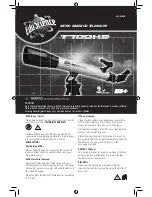
- 18 -
Astronomical Observations
For extended astronomical observations, it is best to mount the telescope in the equatorial
configuration. When aligned to the celestial pole, the telescope is oriented so that the
horizontal and vertical axes of the telescope coincide with the coordinate system in the
sky (see figure). 28 on page 15).
NOTE!
For equatorial (parallactic) alignment, it is essential that the interface field is located to
the right of the pole height adjustment (3, fig. 29) is located.
If you want to point the MCX at the celestial pole, it is essential that you develop an
understanding of how and where a cosmic object can be located as it moves through
the sky. This section introduces you to the basics of astronomy and includes instructions
for finding the celestial pole. You will also learn about tracking objects in the night sky,
familiarizing yourself with the terms "right ascension" and "declination".
Azimuth mode:
The tripod head is clamped at 90°.
Equatorial mode:
The tripod head is clamped to the geographical latitude angle of the
observer.
Celestial coordinates
All cosmic objects are mapped with a coordinate system on the celestial sphere (fig.
30). This celestial sphere is regarded as an imaginary sphere that surrounds the entire
earth and to which all the stars seem to be attached. The celestial mapping system
corresponds to the earthbound coordinate system of longitudes and latitudes, simply
projected onto the imaginary celestial sphere.
The two poles of the celestial coordinate system are defined as the two points at which
the Earth's axis of rotation in its infinitely wide, fictitious extension to the north and south
penetrates the celestial sphere. In this way the northern celestial pole is located (Fig. 30)
exactly at the point of the sky where the extension of the earth's axis beyond the North
Pole intersects the celestial sphere.
When mapping the earth's surface, the lines of longitude are drawn from the North Pole to
the South Pole. Similarly, the latitudes are drawn as lines in an east-west direction, parallel
to the earth equator. The celestial equator (Fig. 31) represents the projection of the earth
equator to the celestial sphere.
The mapping of the celestial sphere is done in the same way as on the earth's surface:
One describes imaginary lines, which together form a coordinate net. In this way, the
position of an object on the earth's surface can be determined by its length and width.
For example, you can determine the position of the city of Los Angeles in California by its
latitude (+34°) and westerly latitude. Describe length (118°). Similarly, the constellation of
the Great Bear (which contains the Great Dipper) can be determined by its coarse position
on the celestial sphere:
RA = 11h; DEC = +50°
- Right ascension:
The heavenly equivalent of the earthly longitudes is called "right
ascension" or "RA", it is given in the time scale of a 24-hour "clock". It indicates the distance
measured in hours (h), minutes (m) and seconds (s) to an arbitrary "zero line" (RA 0h)
passing through the constellation Pegasus. The coordinates of the right ascension run
from 00h 00m 00s to 23h 59m 59s. In this way, there are 24 main RA lines that run
vertically through the celestial equator at 15° intervals. Objects that are increasingly
further east of the RA reference line (00h 00m 00s) carry increasing RA coordinate values.
- Declination:
The celestial equivalent of the earthly latitudes is called "declination" or
"DEC", it is given in degrees of angle, minutes of arc and seconds of arc (e.g. 15°27'33").
A declination running north of the celestial equator is marked with a "+" sign in front
of the corresponding angular value (the declination of the northern celestial pole, for
example, is +90°). Declinations south of the celestial equator are marked with a "-" sign
(the declination of the southern celestial pole is e.g. -90°). Every point that lies on the
celestial equator itself - which, by the way, runs through the constellations Orion, Virgo
and Aquarius - has a declination of zero - this is indicated as "00°00'00".
Alignment and Orientation
VI
Fig. 30
Start position for equatorial/parallactic
mounting of the MCX on a tripod. (1 = Polar
star; 2 = Clamping height axis; S = Alignment
to south)
The celestial sphere. (1 = Northern celestial
pole (not far from the polar star); 2 = Star; 3 =
Celestial equator; 4 = Southern celestial pole; 5
= Declination;
6 = Right ascension; 7 = Earth rotation)
Fig. 29
S
b
c
d
Содержание MCX Goto Series
Страница 30: ...30 Computerised Handset with LED display VII Fig 35...
Страница 39: ...39...










































